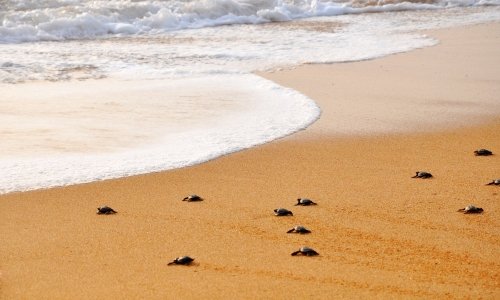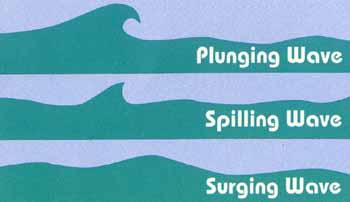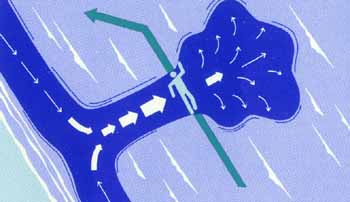
Tips to Make Your Stay in Ocean City Safe & Enjoyable
How Do I Swim Safely?
The most important thing to remember is to swim only when and where guards
are on duty. That is where the surf rescue technicians (SRT's) patrol and
can help if you get into trouble while swimming. WARNING: Never swim before
10:00 a.m. or after 5:30 p.m.
What is a Surf Rescue Technician?
The S.R.T. is an important part of the beach environment. He/she is a strong
swimmer, has knowledge of his/her area and the ability to respond if someone
is in danger. It is important that you cooperate with the SRT in the performance
of his/her duties. IMPORTANT! Whenever you hear a whistle blast, even if
you don't think it is for you, locate the SRT to see what they may need.
Don't be afraid to ask for help and remember to WAVE YOUR ARMS WHEN IN DANGER.
What is a Wave?
A wave is a body of water moving along the surface of the ocean. It loses
speed and gains height when it approaches the shore. As this happens, the
depth of the water below the wave becomes more shallow. The size of the
wave is affected by how strong the wind is and how long it blows. Depending
on the depth of the water, there are three different shapes a wave can assume.
They are as follows:

What is a Rip Current?
Basically, a rip is a body of water moving out to sea. It is the most common
water hazard leading a swimmer to distress and potential rescue. Rips are
found wherever there is a hole or channel in the ocean bottom. As the water
rushes through this area, it becomes churned, collected, and searches for
a way back to sea. Once it finds a path, it rushes through the channel like
a river. This tends to pull any person or object in that area away from
the shore.
What Does a "Rip" Look Like?
- Telltale signs of rip currents are:
- a noticeable difference in water color
- gaps or flat sections in the waves breaking out in the water
- foam or objects moving steadily seaward
- a specific area of water that appears more turbulent than the surrounding water

How Do I Escape from a Rip Current/Washout?
The most important thing to remember is you are caught in a rip is DON'T
PANIC. You should attempt to swim parallel to the shore, with the lateral
current, for about 30 yards and then swim toward the shore. Many people
try to swim against a rip, but this is DANGEROUS. If in danger, wave for
help.
Rules for the Surf:
- Check with the Beach Patrol SAT concerning surf conditions
- Learn to swim and obey the rules of the swimming area
- Never swim alone and swim in patrolled areas only
- Never dive into unknown water or shallow breaking waves
- Don't swim near wooden or rock jetties or the pier
- Rely on your swimming ability rather than a flotation device
- If you are unable to swim out of a strong current, call or wave for help
- The ocean can be unpredictable so treat it with respect
What is a Current?
A current, also known as a littoral drift, is caused by water running parallel and between the beach and a sand bar. These currents are often undetectable by sight and can catch swimmers off guard. Don't panic if you are being moved along the shore. Simply make your way to the beach and walk back to where you entered the water.
What is Dangerous Shorebreak?
Shorebreak is the condition that arises when large waves break directly on the shore. Consequently, swimmers in shorebreak land directly on the sand. These waves are unpredictable and dangerous because they can cause serious shoulder, neck and spinal injuries to even the most experienced swimmer.
Prohibited (P) or Restricted (R) on the beaches of Ocean City
P: Allowing dogs in the beach (May 1 - Sept. 30)
P: Sleeping on the beach (10 pm - 6 am)
P: Using a skim board after 10 am and before 5:30 pm
P: Bringing glass containers onto the beach
R: Starting open fires on the beach
R: Playing loud music
These activities are under the discretion of the beach patrol
R: Ball playing and frisbee throwing
R: Umbrella placement beyond established line
R: Kite flying
R: Use of boogie boards with skegs on the bottom
R: Digging holes in the sand
R: Fishing while the O.C.B.P. is on duty
We would also like to suggest that you always follow these safety tips.
- Keep valuables off the beach
- Drink plenty of water
- Wear Eye Protection
- Apply sunscreen liberally and often
- Establish and check landmarks
- Review with your small children safety procedures in the event that (s)he becomes lost
- And finally, take seriously the warning of the SRT when storms are in the area. The Ocean City Beach Patrol is in constant communication with the National Weather Service. When instructed by beach patrol personnel, please secure your belongings and leave the beach immediately for your safety and ours!
The Town of Ocean City Beach Patrol, in cooperation with the Eastern Surfing Association, establishes rotating surfing beaches, one in the north and one in the south, which rotate two blocks south each day. Each beach is exactly one block wide and is administered to by a surfing beach facilitator. Brochures showing the day-to-day location of the surfing beaches are distributed by the E.S.A. to most area surf shops and are available upon request at the Beach Patrol Office.
Important Phone Numbers:
- EMERGENCY ... 911
- Beach Patrol ... 289-7556
- Recreaton and Parks Department ... 250-0125
- O.C. Police (non-emergency) ... 723-6610
- United States Coast Guard / Boating Safety and Law Enforcement ... 289-7559
- Marine Police ... 289-8463
- City Hall ... 289-8221
Beach Safety Seminars are presentations conducted by the staff of the Ocean City Beach Patrol. The purpose of these seminars is to promote public awareness of safety issues at the beach. The seminars are held on the beach every Sunday morning and begin at 10:30 a.m. They are approximately 30 minutes long and are located throughout the 10 1/2 miles of beach. Please see your nearest lifeguard for the safety seminar closest to you. Beach Patrons of all ages are welcome and encouraged to attend. The seminars are free of charge.
